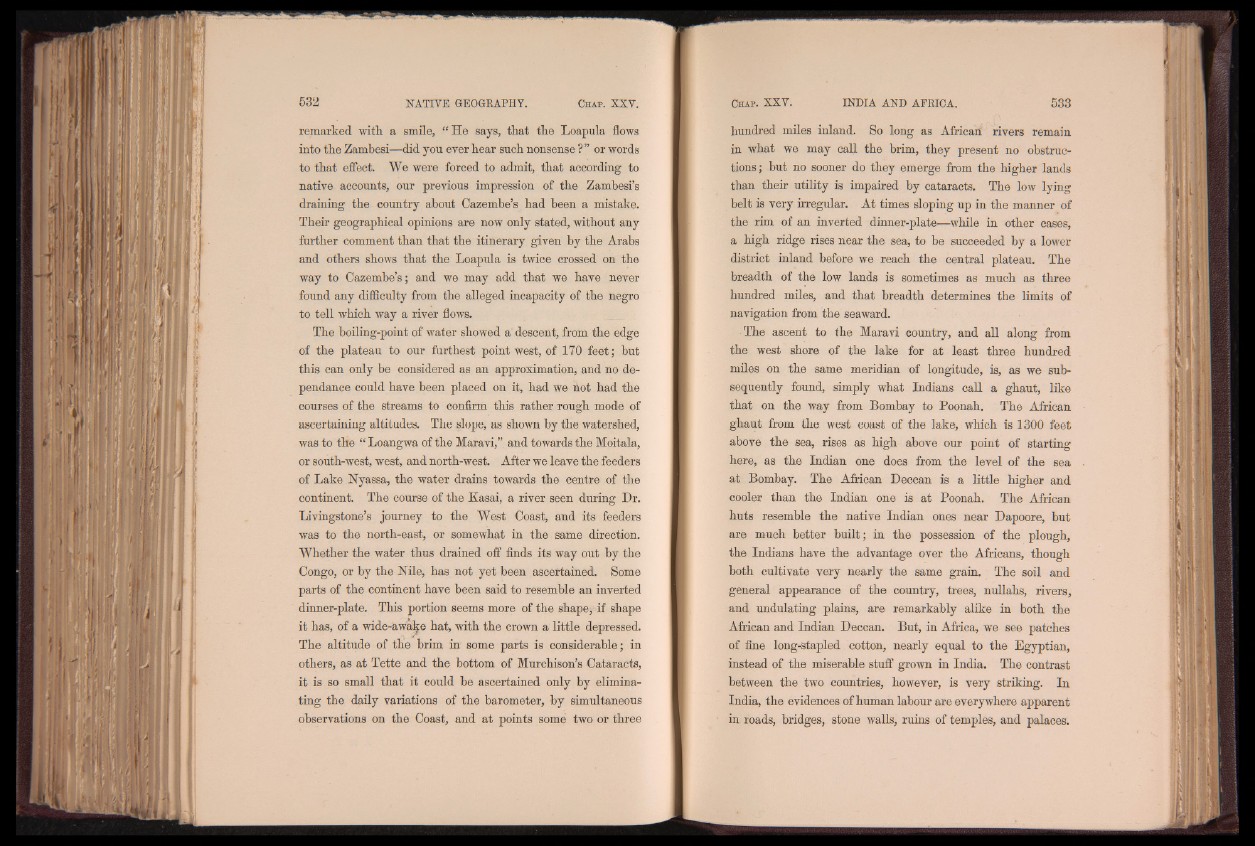
remarked with a smile, “ He says, that the Loapula flows
into the Zambesi—did you ever hear such nonsense ? ” or words
to that effect. We were forced to admit, that according to
native accounts, our previous impression of the Zambesi’s
draining the country about Cazembe’s had been a mistake.
Their geographical opinions are now only stated, without any
further comment than that the itinerary given by the Arabs
and others shows that the Loapula is twice crossed on the
way to Cazembe’s; and we may add that we have never
found any difficulty from the alleged incapacity of the negro
to tell which way a river flows.
The boiling-point of water showed a descent, from the edge
of the plateau to our furthest point west, of 170 feet; but
this can only be considered as an approximation, and no de-
pendance could have been placed on it, had we hot had the
courses of the streams to confirm this rather rough mode of
ascertaining altitudes. The slope, as shown by the watershed,
was to the “ Loangwa of the Maravi,” and towards the Moitala,
or south-west, west, and north-west. After we leave the feeders
of Lake Nyassa, the water drains towards the centre of the
continent. The course of the Kasai, a river seen during Dr.
Livingstone’s journey to the West Coast, and its feeders
was to the north-east, or somewhat in the same direction.
Whether the water thus drained off finds its way out by the
Congo, or by the Nile, has not yet been ascertained. Some
parts of the continent have been said to resemble an inverted
dinner-plate. This portion seems more of the shape, if shape
it has, of a wide-awake hat, with the crown a little depressed.
The altitude of the brim in some parts is considerable; in
others, as at Tette and the bottom of Murchison’s Cataracts,
it is so small that it could be ascertained only by eliminating
the daily variations of the barometer, by simultaneous
observations on the Coast, and at points some two or three
hundred miles inland. So long as Africaii rivers remain
in what we may call the brim, they present no obstructions
; but no sooner do they emerge from the higher lands
than their utility is impaired by cataracts. The low lying
belt is very irregular. At times sloping up in the manner of
the rim of an inverted dinner-plate—while in other cases,
a high ridge rises near the sea, to be succeeded by a lower
district inland before we reach the central plateau. The
breadth of the low lands is sometimes as much as three
hundred miles, and that breadth determines the limits of
navigation from the seaward.
The ascent to the Maravi country, and all along from
the west shore of the lake for at least three hundred
miles on the same meridian of longitude, is, as we subsequently
found, simply what Indians call a ghaut, like
that on the way from Bombay to Poonah. The African
ghaut from the west coast of the lake, which is 1300 feet
above the sea, rises as high above our point of starting
here, as the Indian one does from the level of the sea
at Bombay. The African Deccan is a little higher and
cooler than the Indian one is at Poonah. The African
huts resemble the native Indian ones near Dapoore, but
are much better built; in the possession of the plough,
the Indians have the advantage over the Africans, though
both cultivate very nearly the same grain. The soil and
general appearance of the country, trees, nullahs, rivers,
and undulating plains, are remarkably alike in both the
African and Indian Deccan. But, in Africa, we see patches
of fine long-stapled cotton, nearly equal to the Egyptian,
instead of the miserable stuff grown in India. The contrast
between the two countries, however, is very striking. In
India, the evidences of human labour are everywhere apparent
in roads, bridges, stone walls, ruins of temples, and palaces.